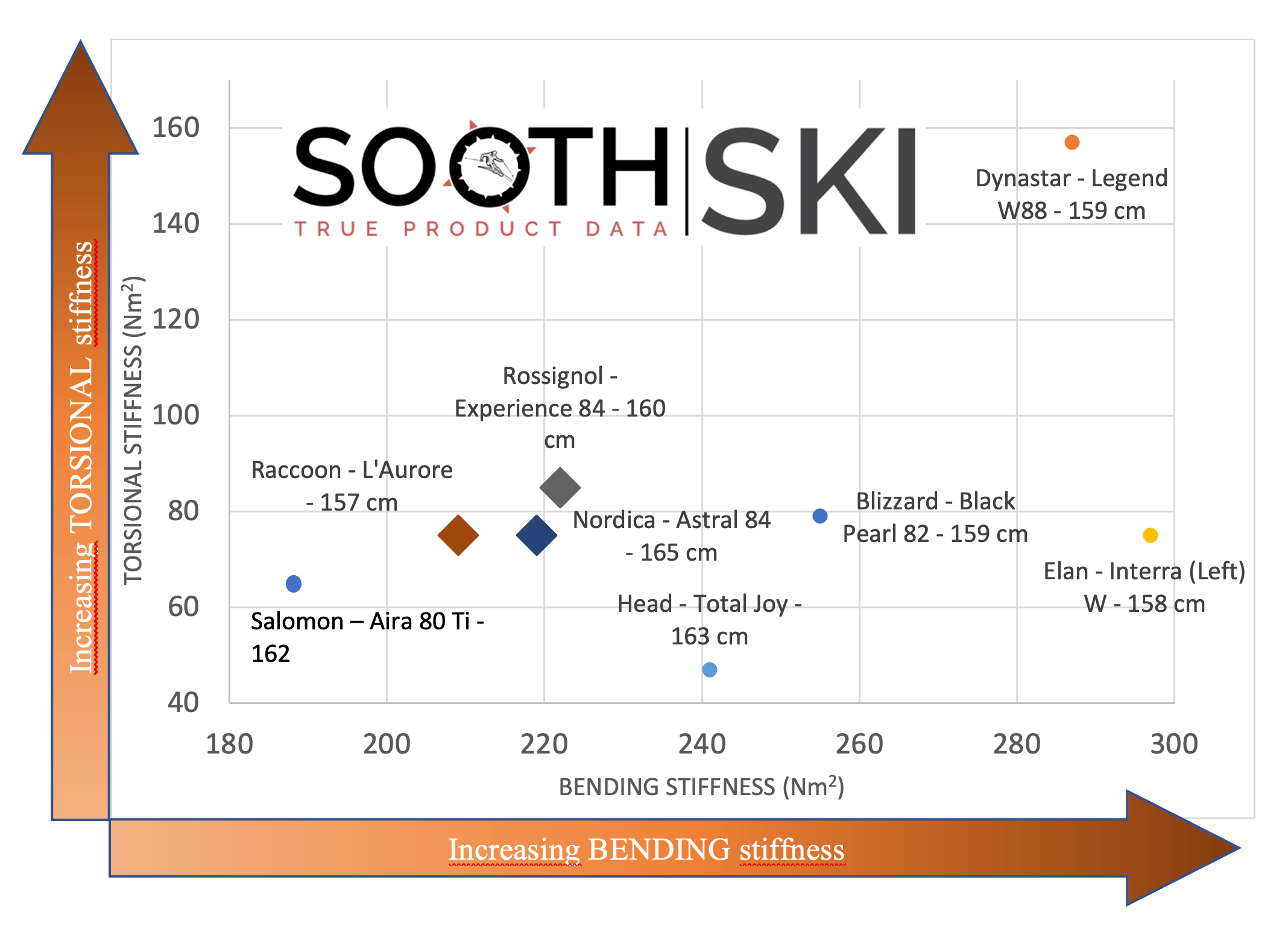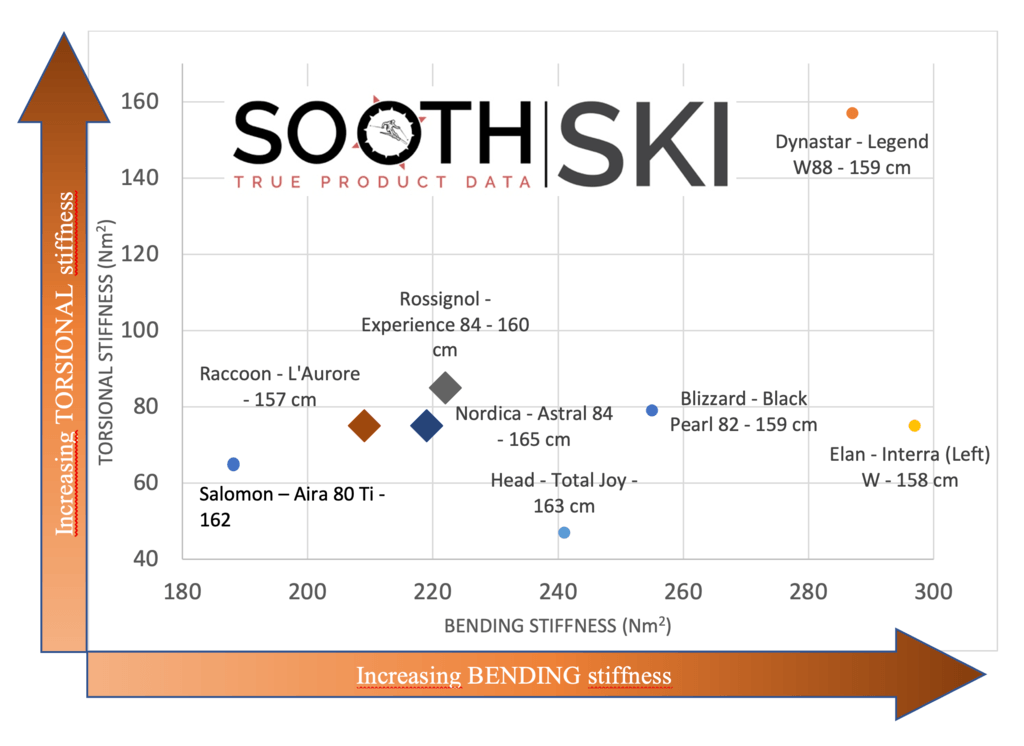To follow our article on all-mountain skis for eastern North America, here is an article on a selection of all-mountain skis for women. As we did for the men models, we identified 8 all-mountain skis for women. Their geometry is similar (radius, length, width). However, they are distinguished by their bending and torsional stiffness. So again, these properties when finding the right ski model for you, are essential. Avoid buying a surprise if you haven't had a chance to try it. Here is our detailed comparison of 8 all-mountain skis for women suitable for skiing in eastern North America.
Women all-mountain skis
Options specific to women in the all-mountain category has been expanding over the past few years. We therefore targeted the brands in demand, a width of 80 to 90 mm, between 155 and 165 cm.
https://soothski.com/welcome-ski-finder-and-comparator-premium/finder-comparator-premium/
To refine further, we focused the waist width between 80 and 88mm, as well as the lengths in 157 and 163cm to obtain 8 options.
As you will see in the following table, the geometries are very similar. The weight of these skis varies between 1.3kg and 1.9kg, making them more oriented skis for slackcountry and piste. Access to bending and torsional data is the only way to find out the differences between these skis, if you don't have the chance to try them out before you buy them.
Brand | Model | Length | Radius | Weight |
|---|---|---|---|---|
Blizzard | Black Pearl 82 | 159 cm | 13,5 m | 1,7 kg |
Dynastar | Legend 88 | 159 cm | 13,2 m | 1,9 kg |
Elan | Interra | 158 cm | 11,3 m | 1,7 kg |
Head | Total Joy | 163 cm | 13,1 | 1,6 kg |
Nordica | Astral 84 | 165 cm | 15,0 m | 1,4 kg |
Raccoon | L'Aurore | 157 cm | 12,4 cm | 1,3 kg |
Rossignol | Experience 84 | 160 cm | 11,5 m | 1,7 kg |
Salomon | Aira 80 Ti | 162 cm | 13,0 m | 1,5 kg |
Average bending and torsion distribution
Interpretation of the stiffness graph
The more rigid the ski is in average bending (to the right), the more energy it requires to flex and the higher its speed limit will be. So you either have to be heavier to enjoy it, ski faster and/or generate a lot of lateral energy during your turns. Of course, the more you like turn-to-turn energy (pop), the more you look at the options on the right. On the other hand, the further to the right, the less forgiving the ski will be in bumps and in soft snow, and the less lively the ski will be at low speed. The more rigid the ski is its average torsion (upwards), the more the ski will grip (edge hold). This is an advantage on firm conditions because it "bites". However, it is less forgiving, requires a lot of precision from the skier and is less “playful”.

Distribution of average bending and torsional stiffness on all-mountain women skis 2020
Now that we have exposed the distribution of the flex and torsion averages, it is obvious that the 8 all-mountain skis identified are very different from one another. Some skis stand out:
- Salomon Aira 80 Ti is clearly the less stiff of all the models presented. Yet it is the only ski with the Ti mention (for the presence of titanal in its construction) !! The presence of titanal is often considered to be a sign of a stiff ski, but this is not always the case. For more details on the titanal, see our article "Does metal really matter in skis?". In short, this skis is ideal for those who don't like to ski at high speed. It is a ski that easily adapts to all conditions and does not require a very advanced technique to enjoy. It is more "playful" than the others.
- Head Total Joy is in the average of this selection for bending stiffness. It is aimed at female skiers who like to ski at medium speed. It is forgiving enough and produces enough energy to propel smoothly between turns. Its torsional average stiffness is lower than the others. It is therefore aimed at skiers for whom technique is not the main concern. It is a ski that will forgive more than the others and will be considered very "playful" and adaptable in all types of conditions and terrain.
- The Blizzard Black Pearl 82 and the Elan Interra are similar skis for torsional stiffness. They require a little more precision. As a result, they offer more grip (edge grip). These are also two skis that are aimed at women who like to ski a little faster. The Elan Interra is also much stiffer in bending stiffness compared to the Blizzard Black Pearl 82, so it is suitable for women who really like speed, without requiring a perfect technique.
- Finally, the Dynastar Legend is by far the stiffest in both bending and torsional. In fact, despite its size of 159cm, its average stiffness is similar to that of skis of around 175cm on the men's all-mountain skis ! This means it is very stiff for this size. This ski forgives little, it suits women skiers who like speed and precision. It grips a lot and propels from one turn to another.
Note that all these comparisons of ski feels are relative. Depending on your weight and style, your on-snow feelings will vary. A ski that is unpleasant for one skier may be ideal for another skier, even if both skiers are looking for the same type of on-snow feels.
On snow feels different
Out of the 8 all-mountain skis presented, it is clear that the skis in this category are heterogeneous. Indeed, the bending stiffness of these geometrically similar skis varies by more than 150% while the torsional stiffness varies by more than 320% !! There are skis for all tastes in this selection. Bending and torsional data is essential for making the right choice. Nevertheless, three models in this selection seem similar even in bending and torsional average values, namely the Raccoon Aurore, the Rossignol Experience 84 and the Nordica Astral 84. They may still have different behaviors on snow which can be explained by looking at the distribution of stiffnesses. We will therefore deepen the analysis by looking at the distributions of the bending and torsional stiffnesses.
Bending and torsion distribution
Interpretation of curves
The following graphs are broken down into four sections. In all cases, the heel of the ski is on the left and the tip is on the right. The horizontal axis is in meters and the "0" corresponds to the "mounting point" as recommended by the manufacturer. 1) The first graph shows a side view of the ski. You can easily compare the camber, rocker and tip shape of all these skis. 2) The second graph shows a top view of the ski where you can distinguish the sidecut, tip taper, etc. The lines in the center of this graph also show the "effective edge" (solid line) and the distance between the widest point of the ski (dotted line). 3) The third graph shows the bending stiffness distribution. The higher the curve at a given location, the more rigid the ski is in flexion at that location. Note that this is not a displacement curve under a given load, but rather the local stiffness (like a spring that is more or less difficult to stretch). 4) The fourth graph shows the torsional stiffness distribution. As for the bending stiffness, the higher the curve, the more rigid the ski is at this point in torsion. Torsional stiffness is the ratio of torque required to "twist" that part of the ski through a certain angle. On piste, skis deform in flexion and torsion. The higher the stiffnesses, the greater the force / torque must be to create this deformation.
Compare in detail the Raccoon Aurore 157, the Rossignol Experience 84 160 and the Nordica Astral 84 165

Detailed comparison - Nordica Astral 84 165 2020, Raccoon L'Aurore 157 2020, Rossignol Experience 84 W 2020
Analyzing these three skis in detail, they are indeed very similar. The differences that we could perceive (very subtle) are as follows:
- (1) The Rossignol Experience is slightly stiffer in torsion and this will be noticeable. It will grip more and forgive a little less;
- (2) Aurora's aft area is softer in comparison to the others, both in bending and in torsional stiffness. It will propel less from one turn to the next, it will seem to have less energy, so it will be more "relaxed" out of a turn.
- Bottom line, these skis are very similar and the Nordica Astral would fit in between the two others!
In short, you have to test, because there is something for everyone! The only way to distinguish skis with similar geometry is by comparing the levels of flex and torsion. To do this, you must either test them on snow, or consult the data from Sooth Ski. Even though the averages are similar, there are obvious differences to be felt on the track and to identify them you have to see their flexion and torsion distribution.
Subscribe to our Newsletter!
Be the first informed of a new article publication

